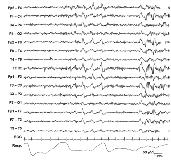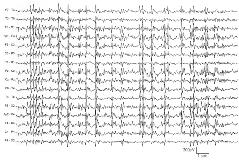Definition of the neurological phenotype associated with dup (X)(p11.22-p11.23)syndrome
Abstract number :
2.391
Submission category :
18. Late Breakers
Year :
2010
Submission ID :
13448
Source :
www.aesnet.org
Presentation date :
12/3/2010 12:00:00 AM
Published date :
Dec 2, 2010, 06:00 AM
Authors :
P. Tinuper, M. Broli, F. Bisulli, M. Mastrangelo, E. Fontana, I. Fiocchi, C. Zucca, M. C. Bonaglia, S. Reitano, R. Corrado, R. Agati, B. Bernardi, D. Cevolani, R. Gallassi, P. Magini, F. Oppi, R. Poda, R. Giorda, O. Zuffardi, B. Dalla Bernardina, M. Seri
Rationale: To describe in detail the neurological features of nine patients (both familial and sporadic) with mental retardation, speech delay, electroencephalogram (EEG) abnormalities and facial dysmorphisms carrying the recently reported microduplication at Xp11.22-11.23 (Am J Hum Genet 2009; 85:394-400.Methods: Clinical and neurological examination, brain magnetic resonance imaging (MRI) (except two patients), EEG and a neuropsychological assessment specific for language disturbances were performed in nine patients with microduplication at Xp11.22-11.23 disclosed by comparative genomic hybridization (CGH) array. Six patients were familial cases belonging to three unrelated pedigrees and three were sporadic cases.Results: The patients had the following characteristics: mild dysmorphic facial features, mental retardation with a moderate-severe global language deterioration; wake and sleep EEG showing epileptiform discharges especially activated during sleep or electrical status epilepticus during slow sleep (ESES) in younger cases; negative brain MRI. Conclusions: The main clinical features of this new chromosomopathy, i.e. Xp11.22-11.23 microduplication, are mild facial dysmorphisms, electrical status epilepticus during slow sleep (ESES) in childhood and a mental retardation mainly involving language function. We are unable to discriminate whether speech impairment in adult cases results from a past ESES no longer evident in adulthood as in our familial cases, but nonetheless able to cause local damage, impairing plastic changes associated with language learning (Epilepsia 2009;50:4-8) (Clin Neurophysiol 2000;111:S94-S102) (Epilepsia 2006;47:40-3) (Brain Res Bull 2003; 62: 143-50), or is due to abnormal brain expression of a dosage-sensitive gene contained within the duplication region ((Am J Hum Genet 2009; 85:394-400).

